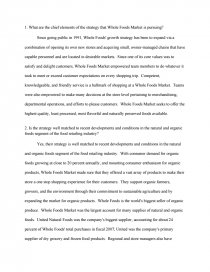Whole Foods
Essay by Paul • March 30, 2012 • Case Study • 532 Words (3 Pages) • 1,434 Views
1. What are the chief elements of the strategy that Whole Foods Market is pursuing?
Since going public in 1991, Whole Foods' growth strategy has been to expand via a combination of opening its own new stores and acquiring small, owner-managed chains that have capable personnel and are located in desirable markets. Since one of its core values was to satisfy and delight customers, Whole Foods Market empowered team members to do whatever it took to meet or exceed customer expectations on every shopping trip. Competent, knowledgeable, and friendly service is a hallmark of shopping at a Whole Foods Market. Teams were also empowered to make many decisions at the store level pertaining to merchandising, departmental operations, and efforts to please customers. Whole Foods Market seeks to offer the highest quality, least processed, most flavorful and naturally preserved foods available.
2. Is the strategy well matched to recent developments and conditions in the natural and organic foods segment of the food retailing industry?
Yes, their strategy is well matched to recent developments and conditions in the natural and organic foods segment of the food retailing industry. With consumer demand for organic foods growing at close to 20 percent annually, and mounting consumer enthusiasm for organic products, Whole Foods Market made sure that they offered a vast array of products to make their store a one stop shopping experience for their customers. They support organic farmers, growers, and the environment through their commitment to sustainable agriculture and by expanding the market for organic products. Whole Foods is the world's biggest seller of organic produce. Whole Foods Market was the largest account for many supplies of natural and organic foods. United Natural Foods was the company's biggest supplier, accounting for about 24 percent of Whole Foods' total purchases in fiscal 2007; United was the company's primary supplier of dry grocery and frozen food products. Regional and store managers also have discretionary authority to source from local organic farmers and supplies that meet the company's quality standards. They own two produce procurement centers that facilitate the procurement and distribution of the majority of the produce they sell and where feasible, local store personnel source produce items from local organic farmers as part of the company's commitment to promote and support organic farming methods. Two subsidiaries, the Pigeon Cove seafood processing facility and the Select Fish seafood processing facility supply a portion of the company's seafood requirements and a regional seafood distribution facility has been established in Atlanta. They have created a not-for-profit Animal Compassion foundation which strives to help producers adopt and improve their practices for raising
...
...

